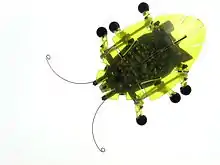Insectoid
The term insectoid denotes any creature or object that shares a similar body or traits with common earth insects and arachnids. The term is a combination of "insect" and "-oid" (a suffix denoting similarity).

Description
Technology
In technology, insectoid robots such as hexapods have been designed for scientific or military uses. Research continues to miniaturize these robots to be used as flying spies or scouts.[1] Insectoid features may also increase the effectiveness of robots in traversing various terrains.[2]
In ufology
In ufology, insectoid aliens are alleged extraterrestrial beings which have a similar body with earth insects or arachnids. These beings are involved in alien encounters and alien abduction scenarios but their presence is not as widely reported as Nordic aliens and Grey aliens.
Before 1990 the UFO reports concerning insectoids included only the Mothman and the Allagash Abductions. In 1992, the alien abduction researcher Brian Thompson claims that a nurse acquaintance of his reported that during 1957 in Cincinnati she encountered a 3-foot-tall (0.91 m) praying mantis–like entity two days after a V-shaped UFO sighting. This mantis-like creature is reminiscent of the insectoid-type entity reported in some abduction accounts. He related this report to fellow researcher Leonard Stringfield. Stringfield told him of two cases he had in his files where separate witnesses reported identical circumstances in the same place and year.[3] Abduction researcher Karla Turner in the book Into the Fringe reported that a man called David remembered an encounter with a giant mantis during an hypnosis session.[4] Linda Moulton Howe in the book Glimpses of Other Realities describes some claims of alien mantises. The book includes the cases of Linda Porter and David Huggins. In 1988 Linda Porter remembered an abduction by alien mantises which she said took place when she was a child. In the same year 1988 David Huggins remembered an encounter with alien mantises that he said took place in the 1950s, when he was a child. The book also reports the case of Jeanne Robinson, which said she has received messages by an alien similar to a mantis. According to Ms. Robinson, these aliens are a branch of Greys.[5][6] Afterwards some fringe of ufologists involved insectoid aliens in UFO conspiracy theories.[7] The skeptic ufologist Martin Kottmeyer argued the phenomenon of mantis alien may be explained by the effects of cultural factors such as science fiction films where these beings are protagonists.[8]
In other media
Insect-like creatures have been a part of the tradition of science fiction and fantasy. In the 1902 film A Trip to the Moon, Georges Méliès portrayed the Selenites of the moon as insectoid.[9] Olaf Stapledon incorporates insectoids in his 1937 Star Maker novel.[10] In the pulp fiction novels, insectoid creatures were frequently used as the antagonists threatening the damsel in distress.[11] Later depictions of the hostile insect aliens include the antagonists in Robert A. Heinlein's Starship Troopers novel[12] and the "buggers" in Orson Scott Card's Ender's Game series.[13]
The hive queen has been a theme of novels including C. J. Cherryh's Serpent's Reach[14] and the Alien film franchise.[15] Sexuality has been addressed in Philip Jose Farmer's "The Lovers"[16] Octavia Butler's Xenogenesis novels[17] and China Miéville's Perdido Street Station[18]
References
- "Scientists developing small robotic drones to become part of Air Force's arsenal". PhysOrg. 2008-09-17. Archived from the original on 2008-09-20.
- "Insectoid robot mimics animal walking styles". TechRadar. 2007-07-25.
- Andrea Pritchard, David E. Pritchard, John E. Mack, Pam Kasey, Claudia Yapp. Alien Discussion: Proceeding of the Abduction Study Conference Held at M.I.T. Cambridge, North Cambridge Press, Cambridge, Massachusetts, 1995
- Karla Turner, Into the Fringe, Berkley Books, New York, 1992
- Linda Howe, Glimpses of Other Realities, Vol. I: Fact and Eyewitness, LMH, 1993
- Linda Howe, Glimpses of Other Realities, Vol. II: High Strangeness, Paper Chase press, New Orleans, 1998
- Arthur Goldwag, Cults, Conpiracies & Secret Societies, First Vintage Books Editions, 2009, p. 136
- Martin S. Kottmeyer, "Bugs Baroque'", UFO Magazine, July/August 1997
- Creed, Barbara (2009). Darwin's Screens: Evolutionary Aesthetics, Time and Sexual Display in the Cinema. Academic Monographs. pp. 47–. ISBN 9780522852585. Retrieved 31 March 2014.
- Prucher, Jeff (2007-03-21). Brave New Words: The Oxford Dictionary of Science Fiction. Oxford University Press. pp. 99–. ISBN 9780199885527. Retrieved 31 March 2014.
- Caroti, Simone (2011-04-14). The Generation Starship in Science Fiction: A Critical History, 1934-2001. McFarland. pp. 63–. ISBN 9780786485765. Retrieved 31 March 2014.
- Roberts, Adam (2006-06-19). Science Fiction. Routledge. pp. 72–. ISBN 9781134211784. Retrieved 31 March 2014.
- Spinrad, Norman (1990). Science Fiction in the Real World. SIU Press. pp. 26–. ISBN 9780809316717. Retrieved 31 March 2014.
- Westfahl, Gary (2005). The Greenwood Encyclopedia of Science Fiction and Fantasy: Themes, Works, and Wonders. Greenwood Publishing Group. pp. 538–. ISBN 9780313329524. Retrieved 31 March 2014.
- Jr., Istvan Csicsery-Ronay (2008). The Seven Beauties of Science Fiction. Wesleyan University Press. pp. 210–. ISBN 9780819568892. Retrieved 31 March 2014.
- Mann, George (2012-03-01). The Mammoth Encyclopedia of Science Fiction. Constable & Robinson Limited. pp. 1915–. ISBN 9781780337043. Retrieved 31 March 2014.
- Bould, Mark; Butler, Andrew; Roberts, Adam; Vint, Sherryl, eds. (2009-09-10). Fifty Key Figures in Science Fiction. Routledge. pp. 44–. ISBN 9781135285340. Retrieved 31 March 2014.
- Westfahl, Gary (2005-01-01). The Greenwood Encyclopedia of Science Fiction and Fantasy: Themes, Works, and Wonders. Greenwood Publishing Group. pp. 1201–. ISBN 9780313329531. Retrieved 31 March 2014.
